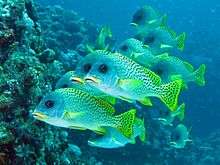Plectorhinchus gaterinus
Plectorhinchus gaterinus, commonly known as the blackspotted rubberlip or African grunt, is a species of fishes belonging to the family Haemulidae.[2]
| Plectorhinchus gaterinus | |
|---|---|
.jpg) | |
| Plectorhinchus gaterinus from South Africa | |
 | |
| Plectorhinchus gaterinus. A small group from Red Sea | |
| Scientific classification | |
| Kingdom: | Animalia |
| Phylum: | Chordata |
| Class: | Actinopterygii |
| Order: | Perciformes |
| Family: | Haemulidae |
| Genus: | Plectorhinchus |
| Species: | P. gaterinus |
| Binomial name | |
| Plectorhinchus gaterinus (Forsskål, 1775) | |
| Synonyms | |
| |
Distribution and habitat
This species can be found in the Western Indian Ocean, from Persian Gulf and the Red Sea to Natal, South Africa, Mauritius, Madagascar and Comoro Islands. These marine tropical fishes are reef-associated and may also occur in sand banks and near estuaries. They can reach a depth of 55 m.[3][4]
Description
Plectorhinchus gaterinus commonly reaches a length of 30 centimetres (12 in), with a maximum size of 50 centimetres (20 in) in males. These fishes have 13 dorsal spines, 19-20 dorsal soft rays, three anal spines and seven anal soft rays. Body of the adults is silvery with black spots and yellow lips and fins. The forehead of the head is gray. Small juveniles show longitudinal black stripes.[3]
Biology
This species is oviparous. Blackspotted rubberlips mainly eat benthic vertebrates, crustaceans and other invertebrates. They usually occurs by day in small groups or large swarms along coral slopes and under ledges.[3]
Bibliography
- Cornic, A. (1987) Poissons de l'Ile Maurice., Editions de l'Océan Indien, Stanley Rose Hill, Ile Maurice. 335 p.
- Fenner, Robert M.: The Conscientious Marine Aquarist. Neptune City, USA: T.F.H. Publications, 2001.
- Garpe, K.C. and M.C. Öhman (2003) Coral and fish distribution patterns in Mafia Island Marine Park, Tanzania: fish-habitat interactions., Hydrobiologia 498:191-211
- Helfman, G., B. Collette y D. Facey: The diversity of fishes. Blackwell Science, Malden, Massachusetts, USA, 1997.
- Hoese, D.F. 1986: . A M.M. Smith y P.C. Heemstra (eds.) Smiths' sea fishes. Springer-Verlag, Berlin.
- Maugé, L.A. 1986. A J. Daget, J.-P. Gosse y D.F.E. Thys van den Audenaerde (eds.) Check-list of the freshwater fishes of Africa (CLOFFA). ISNB Bruxelles; MRAC, Tervuren, Flandes; y ORSTOM, París, France. Vol. 2.
- Moyle, P. y J. Cech.: Fishes: An Introduction to Ichthyology, 4a. edición, Upper Saddle River, USA: Prentice-Hall. 2000.
- Nelson, J.: Fishes of the World, 3a. edición. Nueva York: John Wiley and Sons. 1994.
- Smith, M.M. and R.J. McKay (1986) Haemulidae., p. 564-571. In M.M. Smith and P.C. Heemstra (eds.) Smiths' sea fishes. Springer-Verlag, Berlin.
- Wheeler, A.: The World Encyclopedia of Fishes, 2a. edición, Londres: Macdonald. 1985.